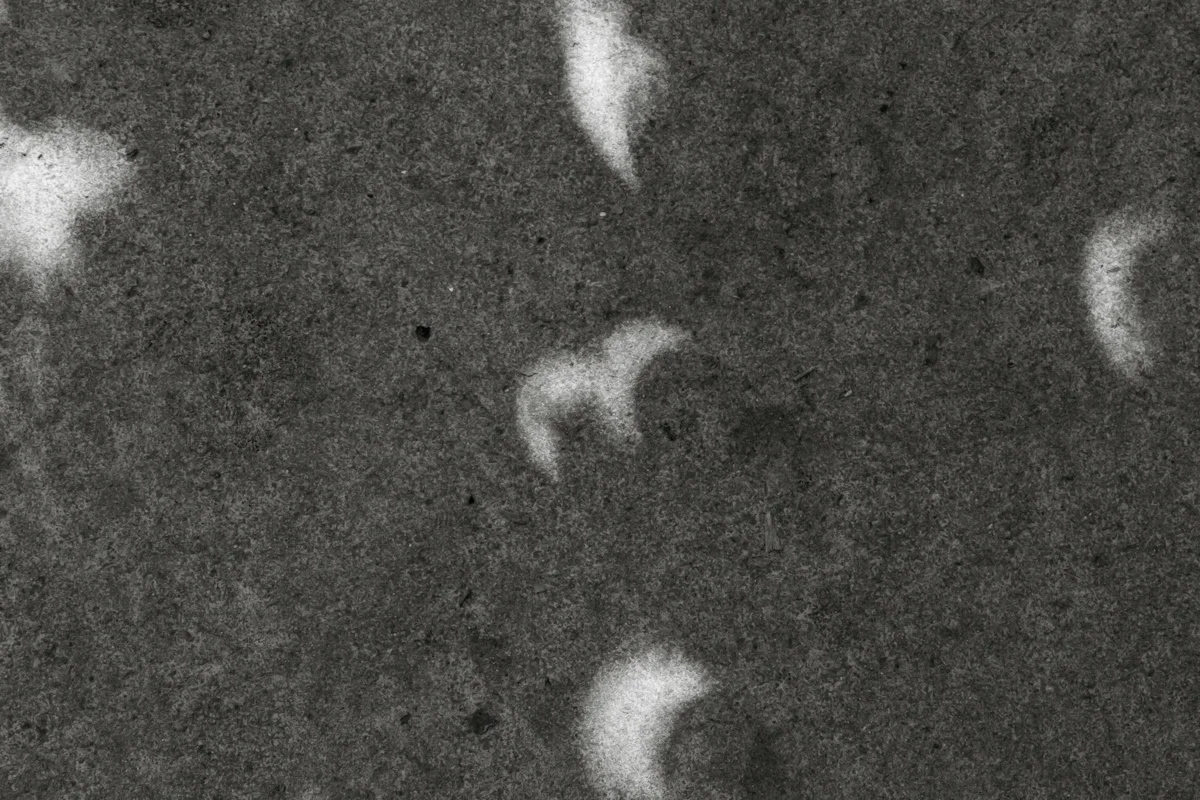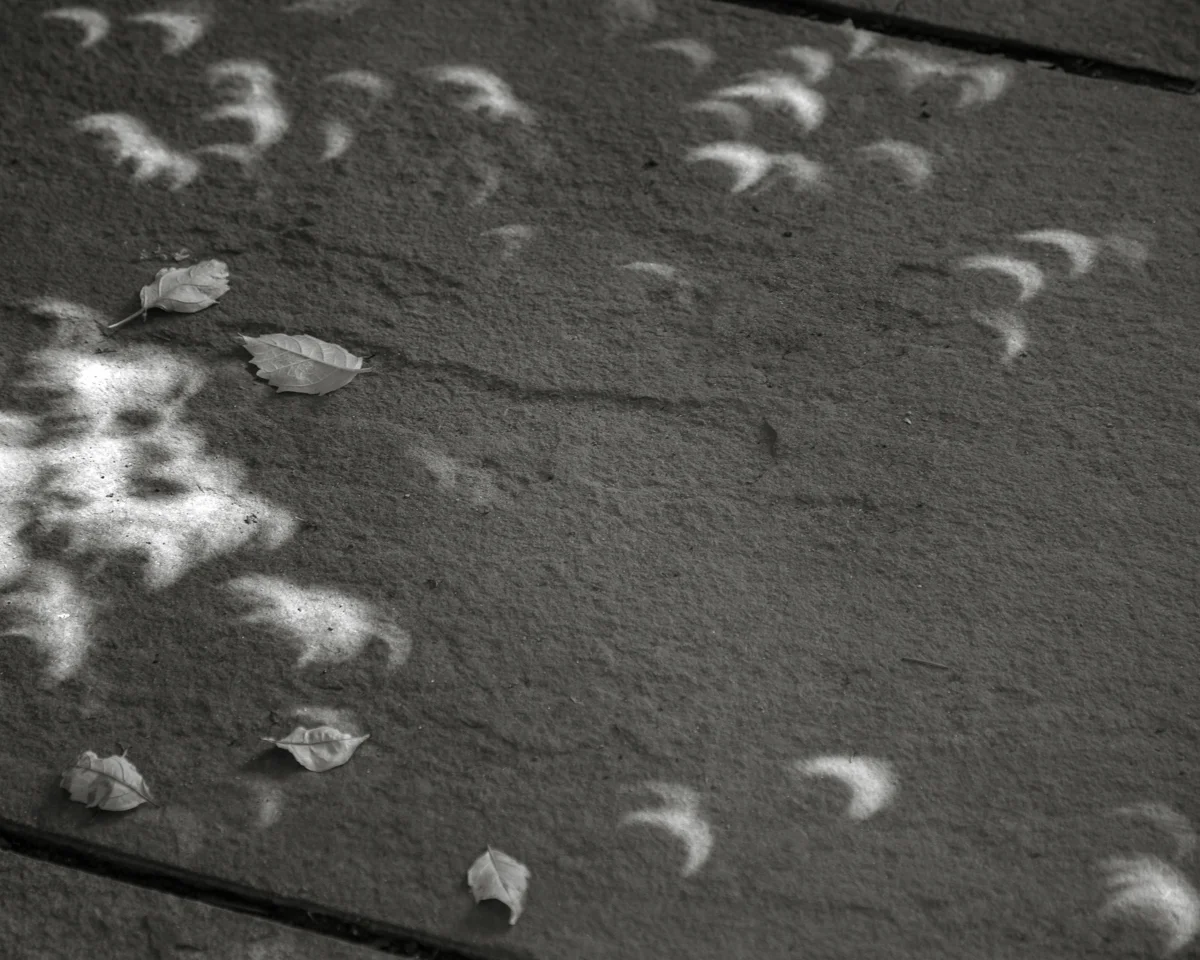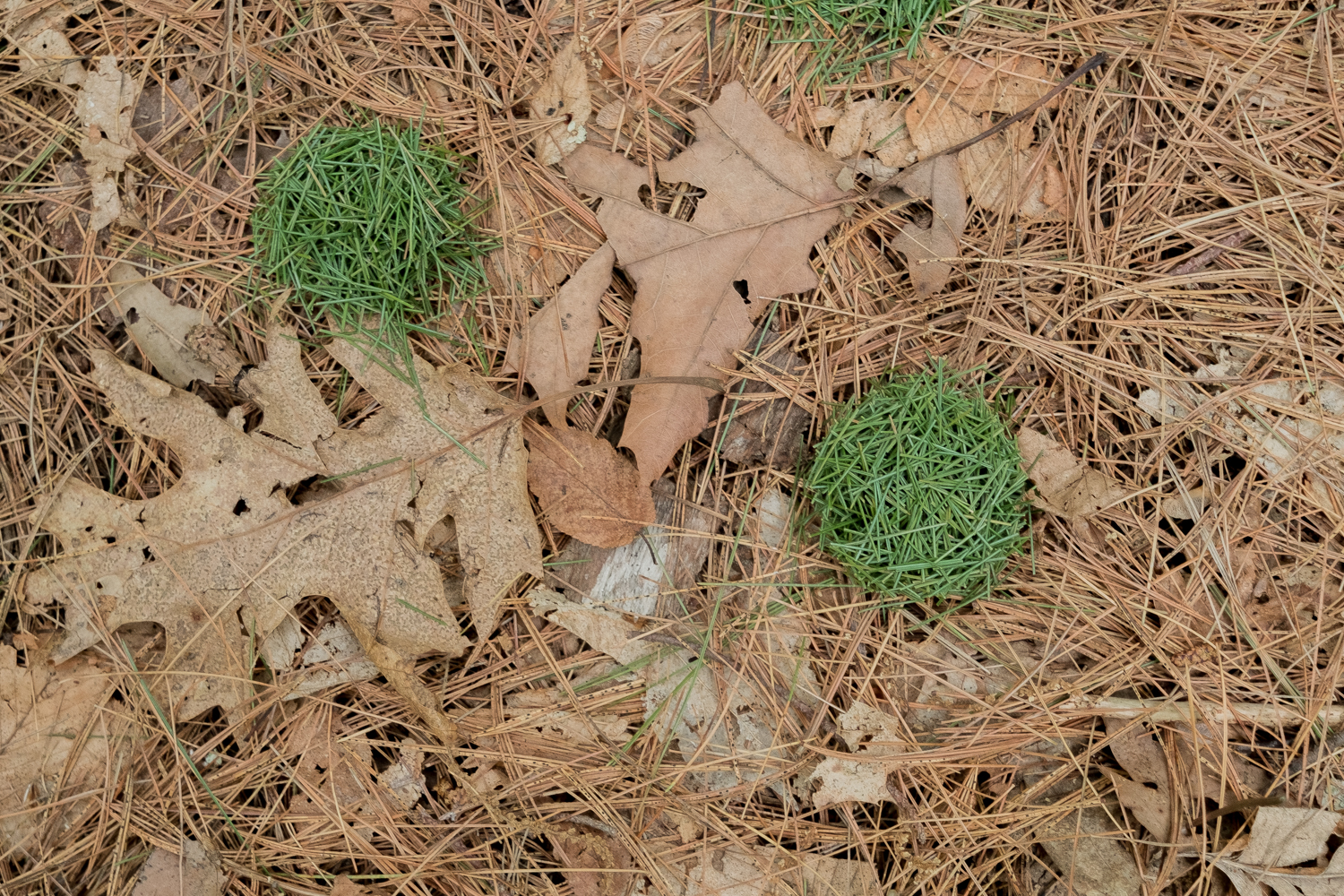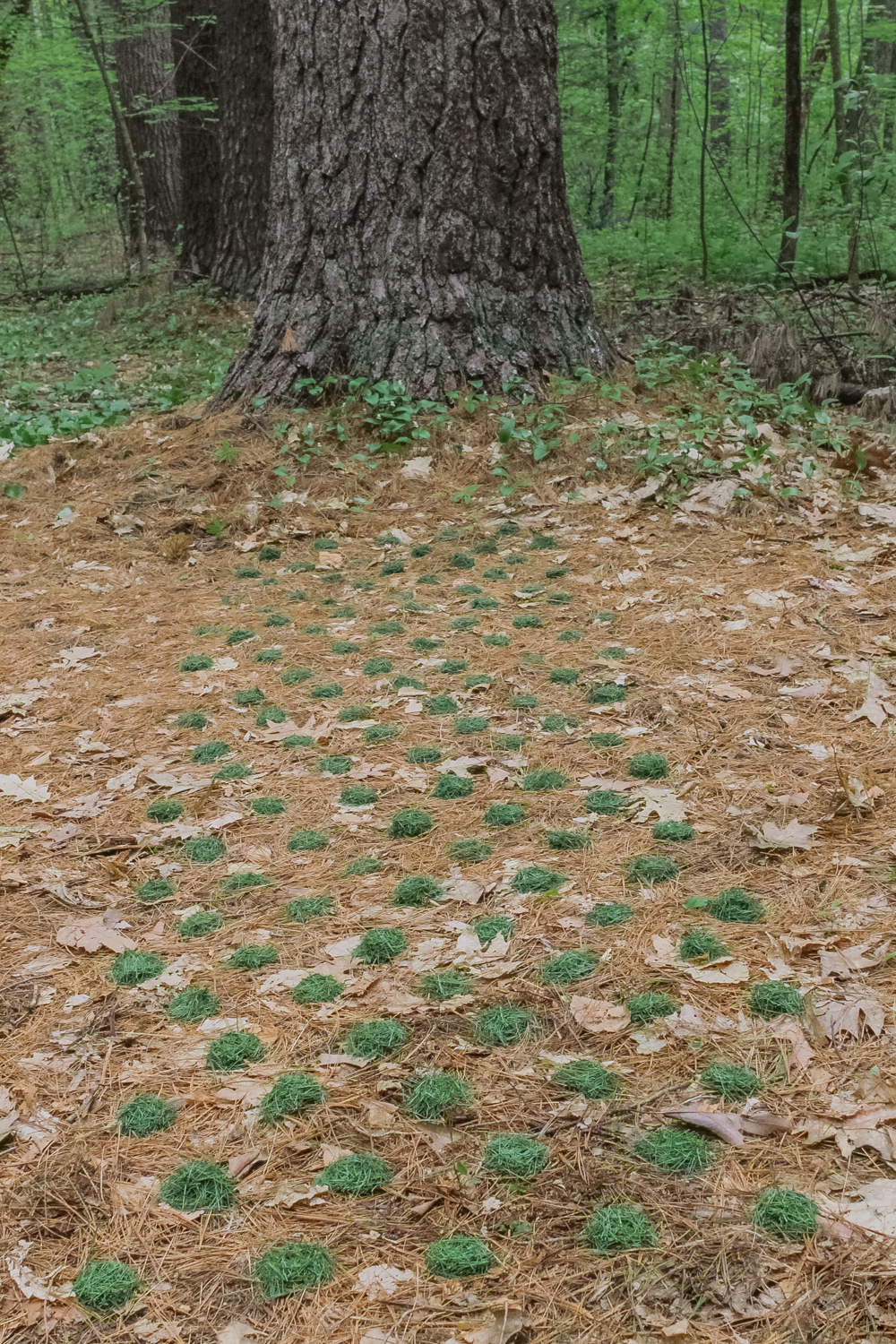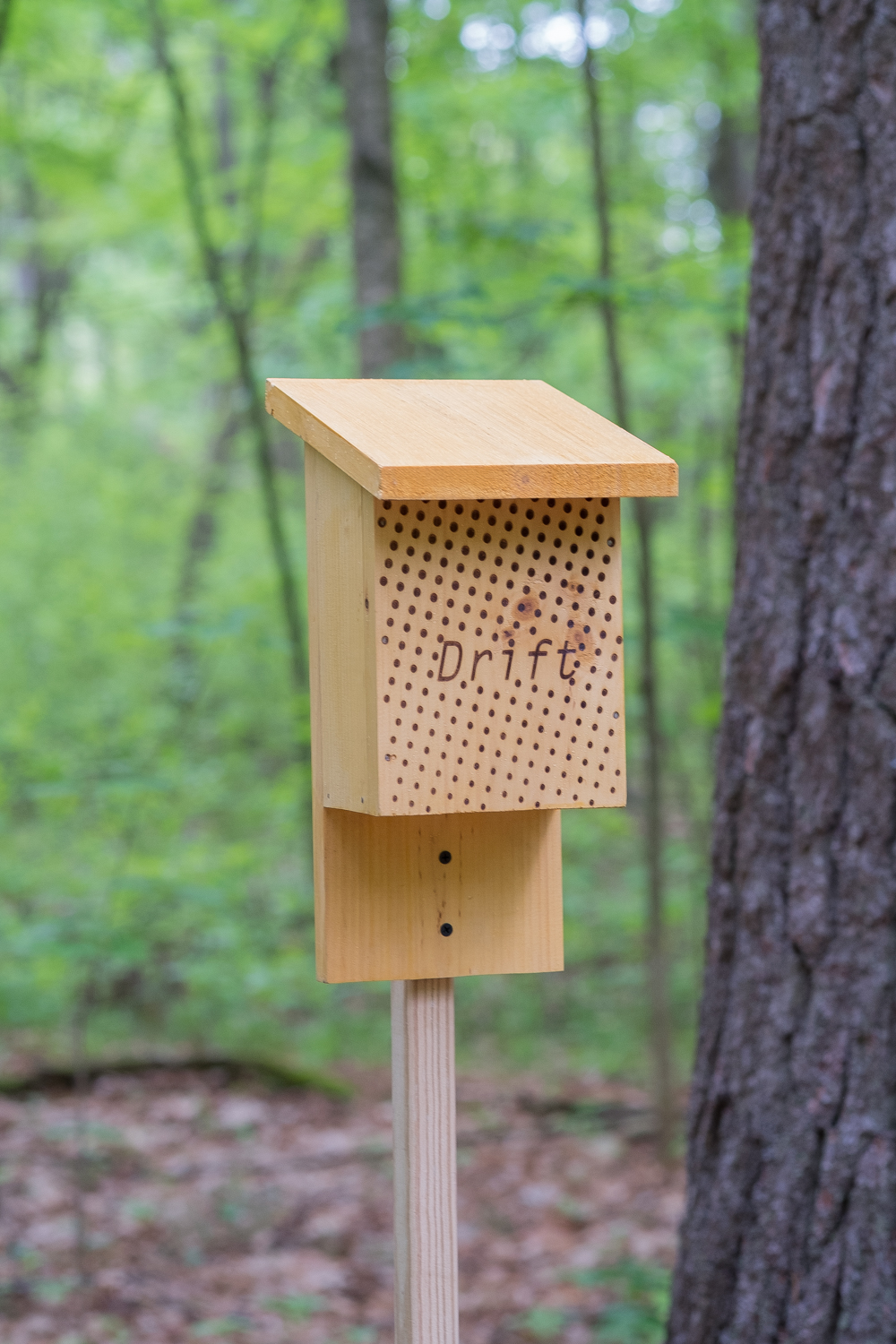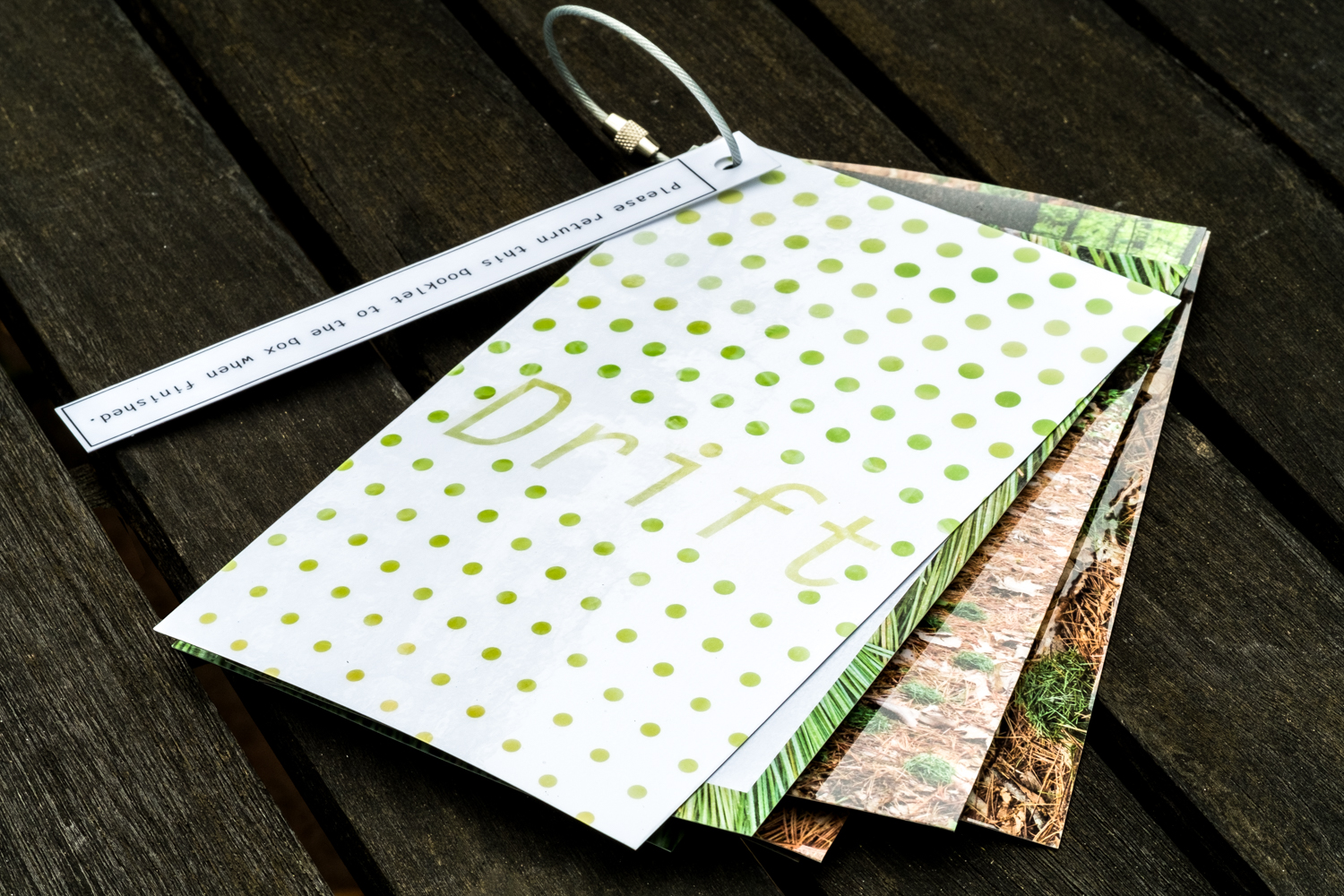Along the Rim Trail at Robert H. Treman State Park, this tree has become a record keeper. One carving dates back to 1968, marking almost 50 years (maybe more) of hikers who stopped to etch their initials here.
Light and Leaves
I watched the phenomenon of the solar eclipse with my good friend Shea Hembrey under a row of katsura trees at the Cornell Botanical Gardens. Years ago, Shea had told me about the camera obscura effect that occurs during an eclipse. It was a hard concept for me to grasp until I had the chance to witness it for myself. The light that filters through the openings between leaves acts like a pinhole camera and projects the image of the eclipse onto the ground. Slowly, almost imperceptibility, the shadows had shifted and crescent shapes of light dotted the pavement all around us.
A dual projection of the eclipse seen through binoculars at the Cornell Botanical Gardens
Mums of Milo
Rows of potted mums at a greenhouse in Milo, NY.
Greenhouse Getaway
I recently discovered the Liberty Hyde Bailey Conservatory Greenhouse on Cornell’s campus that opens its doors to visitors during the weekdays from late morning to mid-afternoon. With the rebuild of the conservatory in 2014, the space was designed with an impressive computerized system for controlling temperature, humidity and light. It houses more than 650 species of plants that thrive in temperate climates. The conservatory has a Palm House and an adjoining Student House that is loaded with a variety of potted succulents, mosses, orchids, delicate ornamentals and carnivorous plants.
This may become my new favorite spot to visit on lunch breaks. I’ll be sure to return during the Ithaca winters to take in some tropical air.
Drift
This past weekend I traveled to Concord, Massachusetts, to install a site-specific installation for the Art Ramble 2017: Slow Eyes, Solace & Site, an exhibition in honor of Henry David Thoreau’s 200th birthday. The site of the installation, within the Hapgood Wright Town Forest, sits in close proximity to Walden Pond. The show is hosted by the Umbrella Community Arts Center and curated by Jenn Houle.
Having never seen the forest before, my project proposal was based on assumptions of what I might find when I arrived there. The concept of my installation piece entitled, Drift, was loosely based off of a print I had made earlier this year, Pine Needle Polka Dot. I wanted to do something similar in form within the landscape. I planned to collect plant material from the forest floor, possibly pine needles if available, and arrange them into piles that would sit onto a contrasting color. With the inherent impermanence of the work, I planned to have a photographic reference on site for viewers to experience the piece as it had once existed.
After arriving in Concord on Saturday afternoon, I walked the trails of the forest and looked for contrasting colors to create my work. Many of the paths were covered with dried, orange pine needles. My location within the forest was a clearing just off the path that was densely covered in orange needles. I also noticed that the freshly fallen branches from the white pine trees still had green needles. I collected these branches and began removing the needles for the installation.
There was one small hitch in my original plan. The fallen branches had needles that were about 3 to 4 inches in length. They didn’t fit the 2 inch diameter tubes and template I had designed in anticipation for the installation. I soon realized I would need to add another step in my process and trim them down to smaller sizes, to about 1 inch. I spent a good part of the following morning on Sunday trimming pine needles over my morning coffee.
I took the trimmed pine needles back to the forest were I organized them into repeating circular piles onto the contrasting orange needles below. With the feeling that it might downpour at any moment, I photographed the progress as I worked. A few times I felt raindrops but the storm held off. I was able to install 123 piles and covered an area approximately 2 feet by 8 feet with the quantity of green needles I had trimmed earlier in the day.
Back at my computer, I sorted through the images. Part of my consideration in planning for the piece was to have a booklet that would hold images, so I had brought a mobile lab along with me in my car which included a laptop, printer and laminator. On my last day in Concord, I printed the booklet as a reference for viewers. The booklet sits in a box I had constructed ahead of the installation, designed to look like a trail map box (special thanks to Chris Oliver for the box-building assistance).
Over the course of the installation, the green will fade and the forces of wind and rain will erase the pattern. The piles will scatter and return to a state of randomly dispersed matter. Drift is a reflection on the passage of time and the pressures of nature that will inevitably eradicate the work.
The exhibition opens on June 1st and will run through September.
Tulip Trance
Happy Accidents
One of the great delights of making artwork are the occasional happy accidents. It’s not often, but sometimes a few disparate things will align, and I’ll get an unanticipated outcome that I’m excited about. It can surface in the midst of working in my studio when I have no particular expectation in mind. This is what happened with this piece I recently made, Pine Needle Polka Dot.
Earlier in the winter, I had collected some pine branches for a project I was working on. Predictably, the branches dried out and all the pine needles fell off. Around this time I was recording audio for an unrelated video project, and I was experimenting with the sound that the pine needles made sliding across paper and falling onto different surfaces. Among my varied sound tests, I dropped the pine needles down a cardboard tube. There was nothing particularly interesting about the sound. Ready to move on, I picked up the tube and there it was; my happy accident. It was a circular pile of pine needles. I was looking for a sound, but instead I got what would become the image for a print.
It’s moments like this that remind me how much I enjoy the time spent in my studio looking for something I can’t yet define. From pine needles to cardboard tubes, studios are the places that small and unexpected things can happen.
As I worked, I began to see that I could control the scatter of the pine needles by adjusting the distance of the tube in relation to the surface. Who knew? Who would think to look? The only way I’ve ever been able to create artwork is to get curious about something. It can be something as inconsequential as pine needles down a cardboard tube. I love the mystery of making.
Out of this happy accident, a happy piece was made. I had fun with this work, and it lead me to think about doing this process as a larger installation. I’m pleased to announce that I’ll soon have the unique opportunity to do just that. This summer I’ll be creating a site-specific installation in the Hapgood Wright Town Forest in Massachusetts. This exhibition is in honor of the 200th birthday of Henry David Thoreau and is entitled, Slow Eyes, Solace & Site. I’ll be writing more about the installation in the coming months, so check back!
In the words of Thoreau (and also the encompassing statement for the exhibition), “We must look a long time before we can see.”
Pine Needle Polka Dot, Digital Pigment Print, 17.5” x 14.25”, 2017
Avocado Tree
I rescued an avocado tree from our compost pile where I found it growing from a discarded pit. At the time it was no more than 6” tall. Over the past couple years, this little tree has grown to a height of about 30”, biding its time during the colder months in a pot by the window.
It has large, oblong leaves that are very expressive. When it’s happily enjoying the warmth and sunlight, it fans out its leaves. When it’s cold or needs water, it quickly deflates.
In this brief moment of winter sunlight, the avocado tree stands resilient, looking forward to sunnier days ahead when it can head back outside and stretch out.
Birds in the Bramble
Crows clustered together along the tree branches on a wintery late afternoon in Ithaca.
Snow Globe
Along Interstate 86 from Allegany to Ellicottville, NY, the surrounding hills were looking spectacular with a new coat of white from the recent snowfall. It’s no wonder these hills are nicknamed the Enchanted Mountains.
From Concolor to Canaan
A post-Thanksgiving tradition when I'm home visiting family includes going to a local Christmas tree farm to pick out a pine for the house. This year we went to Johnson’s Santas’ Forest in Franklinville, NY.
I’ve always found it enjoyable to walk around the strait rows of triangularly trimmed trees searching for the one that will be part of our house for the coming month.
It was a wet day and we sloshed around the grounds looking for a Concolor tree, similar to what we had last year. There was a limited selection of this particular type, so we scouted some other varieties nearby and settled on a Canaan Fir with a wide base that was a good height for our ceilings.
I did feel a pang of sadness as we carried away our selected tree, leaving a stump in its place, but I’m glad there’s a market for Christmas trees that encourages people to plant so many varieties of pines in the first place.
It never fails to be a surprise bringing the tree inside the house. It looks relatively small in the field among the other trees, but it becomes an enormous presence once it's part of the living room.
Happy tree season everyone!
From left to right: Megan, Kevin, Mike and Marieke
Good Life Farm
Cider Week
The beginning of October was Cider Week in the Finger Lakes region. On the last days of the week-long list of events, Lou and I visited two locations on the map nearest to us; the Finger Lakes Cider House at Good Life Farm and Redbyrd Orchard. We tasted some local hard ciders and wandered around the farm properties. Both of these spots are no more than about five miles from our house in either direction. We have so many agriculturally-minded folks around us– it’s inspiring to discover new and amazing things people are doing just up the road. I have enormous admiration for those who make a career out of growing things.
Greenhouse at Good Life Farm
White geese at Redbyrd Orchard hanging among the young apple trees
Looking back at the road from Redbyrd Orchard
Sheep at Redbyrd Orchard
Sonnenberg Gardens
On a Sunday afternoon this September, Lou and I visited Sonnenberg Gardens in Canandaigua, NY. The 50-acre estate has an aura of aging grandeur. Among the gardens and greenhouses, you can catch a glimpse back to 100 years ago when it must have been spectacular. After having changed hands a few times in it’s history, the estate is now managed by New York State as a historic park. It’s a fun place to wonder about and marvel at amount of labor that went into the landscaping, greenhouses and other architectural details, not to mention all of the upkeep it must of required in it’s heyday. I credit the people who have worked to preserve the estate and keep the the grounds maintained after it had fallen into disrepair over the years. It's no small task considering the size and complexity of the project. It is still a vibrant, fascinating place to visit with a slightly haphazard and forgotten feel about it.
Propagation House
The Vinery was one of the earliest additions to the greenhouses at Sonnenberg
Hanging pots in the Orchid House
Coy fish in the pond near the entry/exit of the grounds
Fern Fronds
The summer is coming to a close, and the growing season will soon follow. The daylight hours are becoming notably shorter at the beginning and end of each day. I’ve been slowly expanding on the garden beds around our house and planning to add more perennials in some of the bare spots this fall. While weeding and pruning, I collected some clippings from our faithful Ostrich Fern that returns each year in the early spring and stays through the fall. It has also produced a few baby ferns, which I’ve transplanted to other areas of the garden beds.
I find that the New York State winters are a great time for spending long hours in my studio and working on extended projects. The summer months are much harder for me to stay put at my desk with the continual pull of beautiful days, and so much to see and do outside. I’ve noticed a natural cycle in my process of making artwork; the summer is the time for new ideas and for collections, and the winter is a time to make the ideas a reality (or at least see where these ideas lead me). The winter poses the problem of not being able to go out and collect what I need to complete a project, so I’m trying to do so now and to preserve what I think may be useful to me later on.
Years ago I had found a small flower press at an antique shop, and I’ve been using it to preserve the fern fronds that I’ve clipped from the stems. I’ll check back after a week or so, allowing pressure and time to preserve their fragile forms.
Lucky Break
This single tree is all that remains in the wake of a rockslide that occurred earlier this summer on the southern side of the gorge at Taughannock Falls State Park. According to park staff, this section of the gorge had become an area of high-risk and was unstable. In an effort to prevent an unpredictable slide, a man-made avalanche was set in motion under controlled circumstances. Among a heap of rocks, this one tree managed to hold its ground.
Dia Trees
Robert Irwin at Dia Beacon, Beacon, NY
On a recent visit to Dia Beacon, Lou and I spent some time wandering around the grid of trees near the entrance to the museum. The geometric planting is the design of artist Robert Irwin. The squarely trimmed branches create living walls that rise above two intersecting boardwalks going nowhere. It was a contemplative spot to getaway to, and I snapped this funny picture of Lou in the midst of it.
Slow Escape
Forgotten greenhouses in Wallkill, NY.
Feather Plant
Moss Time
Through the month of April, I’ll be showing my Satellite series of prints at eye gallery on the Commons in downtown Ithaca. If you’re in the area, you should stop by tomorrow night, April 1st, from 5:30-7:30 p.m. for the reception. I’ll also have a limited edition print available that is related to the Satellite works. You can view the Satellite print series here.
For the last few years, I’ve been collecting moss and bringing it back to my studio. I started to notice that there was a lot of variation in forms, and I later discovered there are basically two types of moss: Acrocarpous and Pleurocarpous, the first being a slower-growing variety that tends to emerge in a more upright manner and often found in dense mounds, and the second type having a chaotic, sprawling growth pattern that regenerates more quickly than the first.
I had originally tried to keep my moss collections hydrated and living, but ultimately they all dried out as I became less disciplined with my watering routine. I was surprised to find that the form of moss hardly changed when dried, but mostly there was a discernible shift in color and texture, from vibrant, lush greens, to an ashen, brittle version of its former self.
For the first work in the Satellite series, I constructed the form entirely with living moss, thinking that the color would be a pertinent part of the work. After photographing the piece, I ultimately tossed the color, finding that it distracted from the intricacy and complexity of the moss. I had stitched together many photographs of the form to achieve the focus and resolution I wanted, but I felt it was far too much information and didn’t achieve what I ultimately wanted. By isolating the image down to tonal fields (much like I might do in the creation of a screen print image) I found that the piece took on a new quality, like that of a fossil, or of a planetary body seen from afar where the detail gets lost in the distance.
For the second Satellite print, I started collecting moss that was popping up in small, circular forms on our home’s shingled roof. Conveniently, this roof is right out my studio window, so I would go out and scrape the moss and come back in to make my arrangements. I started to wonder about the consciousness of moss, and think how odd it would be if the moss arranged itself into neat halftone patterns, and thus my idea for Satellite no. 2 came about.
For Satellite no. 3, I mixed it up a bit and used lichen. There’s a great, peaceful spot near the Finger Lakes National Forest called Ballard Pond, and around the pond, an old wooden fence has been overtaken with lichen. From my observations, lichen is more finicky than moss about where it will grow, but for whatever reason it thrived on this fence. This is where I collected all the lichen for this piece, and I found that it had nearly no discernible change in appearance when uprooted, except that it became more fragile when dried out. For this work I used the same circular form and process of extracting detail, but for this piece I wanted it to have a stark polarity with the other two in the series, so I inverted the tones.
These works were printed as an edition of two, 40 in. x 40 in. inkjet prints. They have now made their way around New York State to three shows including the Dowd Gallery at SUNY Cortland, the Olean Public Library Gallery, and now back through Ithaca being shown at eye gallery.
Through March, with the upcoming show in mind, I revisited some of the ideas I was working with in the Satellite pieces, and worked on a smaller scale. I repurposed some of my moss from the earlier works and based the arrangement on the Fibonacci sequence often seen in plants, such as the way sunflower seeds grow in a spiral pattern. When photographed and printed, I felt the work needed something more, so I took my edition of 25 to the silkscreen studio and laid down a layer of very translucent ink as a background color and overlay to further enforce the shape of a gibbous moon (the moon when in a state between half and full), which is where the work gets its title, Gibbous Sphere.
Gibbous Sphere (detail), Inkjet and silkscreen print, 13.5" x 11", 2016
This past winter, I read Elizabeth Gilbert’s, The Signature of All Things, and her main character, a botanist, gets caught up in the concept of “moss time” vs. human time– the idea that moss is on a totally different time scale than we are as humans, and while it moves incredibly slow by comparison to us, it has its own trajectory in the course of its long life.
I hope you can join me tomorrow evening at eye gallery. By the way, Lou will be playing music for the opening reception too, so that’s even more reason to come out!
The view at the top of the Tannenbaum lift near the Happy Glade trail
Happy Glade
This past weekend while we were back in the snowbelt region of Western NY, Lou and I took the opportunity to spend a Saturday at Holiday Valley in Ellicottville. This is the spot where I first learned to snowboard in highschool. The Tannenbaum Quad lift was always my favorite ride because it takes you on a peaceful route through the woods and drops you among hundreds of long-trunk pine trees. While nearly everything in my life has changed since those ski club days, this spot seems frozen in time, and just as beautiful as ever.


